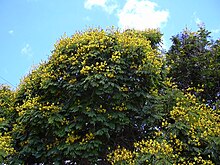Yellow flame tree
| Peltophorum pterocarpum | |
|---|---|
 |
|
| Scientific classification | |
| Kingdom: | Plantae |
| (unranked): | Angiosperms |
| (unranked): | Eudicots |
| (unranked): | Rosids |
| Order: | Fabales |
| Family: | Fabaceae |
| Genus: | Peltophorum |
| Species: | P. pterocarpum |
| Binomial name | |
|
Peltophorum pterocarpum (DC.) K.Heyne |
|
| Synonyms | |
|
|
Peltophorum pterocarpum (commonly known as copperpod, yellow-flamboyant, yellow flametree, yellow poinciana or yellow-flame) is a species of Peltophorum, native to tropical southeastern Asia and a popular ornamental tree grown around the world.
It is a deciduous tree growing to 15–25 m (rarely up to 50 m) tall, with a trunk diameter of up to 1 m belonging to Family Leguminosae and sub-family Caesalpiniaceaea. The leaves are bipinnate, 30–60 cm long, with 16-20 pinnae, each pinna with 20-40 oval leaflets 8–25 mm long and 4–10 mm broad. The flowers are yellow, 2.5–4 cm diameter, produced in large compound racemes up to 20 cm long.
The fruit is a pod 5–10 cm long and 2.5 cm broad, red at first, ripening black, and containing one to four seeds. Trees begin to flower after about four years.
Peltophorum pterocarpum is native to tropical southeastern Asia and northern Australasia, in Sri Lanka, Thailand, Vietnam, Indonesia, Malaysia, Papua New Guinea and the islands off the coast of Northern Territory, Australia.
The tree is widely grown in tropical regions as an ornamental tree, particularly in India, Nigeria, Pakistan, and Florida and Hawaii in the United States. The trees have been planted alternately in India as a common scheme for avenue trees in India alternately with Delonix regia (Poinciana) to give a striking yellow and red effect in summer, as has been done on Hughes road in Mumbai.
...
Wikipedia
